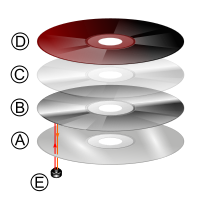Welcome to the Multimedia Course : Design Issues
OER initiative for Building Collabrative Learning for Multimedia
Intoduction
Compact Disk
The Compact Disc (also known as a CD) is an optical disc used to store digital data. It was originally developed to store and playback sound recordings exclusively, but later expanded to encompass data storage (CD-ROM), write-once audio and data storage (CD-R), rewritable media (CD-RW), Video Compact Discs (VCD), Super Video Compact Discs (SVCD), PhotoCD, PictureCD, CD-i, and Enhanced CD. Audio CDs and audio CD players have been commercially available since October 1982.
Standard CDs have a diameter of 120 millimetres (4.7 in) and can hold up to 80 minutes of uncompressed audio or 700 MB (700 × 220 bytes) of data. The Mini CD has various diameters ranging from 60 to 80 millimetres (2.4 to 3.1 in); they are sometimes used for CD singles, storing up to 24 minutes of audio or delivering device drivers.
CD-ROMs and CD-Rs remain widely used technologies in the computer industry. The CD and its extensions are successful: in 2004, worldwide sales of CD audio, CD-ROM, and CD-R reached about 30 billion discs. By 2007, 200 billion CDs had been sold worldwide.[1] Compact Discs are increasingly being replaced or supplemented by other forms of digital distribution and storage, such as downloading and flash drives, with audio CD sales dropping nearly 50% from their peak in 2000.

DVD
A DVD is an optical disc storage media format, invented and developed by Philips, Sony, Toshiba, and Panasonic in 1995. DVD originally stood for Digital Versatile Disk, or Digital Video Disk. The acronym was dropped after DVD proved to have more uses than just storing video content. DVDs offer higher storage capacity than Compact Discs while having the same dimensions.
Pre-recorded DVDs are mass-produced using molding machines that physically stamp data onto the DVD. Such discs are known as DVD-ROM, because data can only be read and not written nor erased. Blank recordable DVDs (DVD-R and DVD+R) can be recorded once using optical disc recording technologies and supported by optical disc drives and DVD recorders and then function as a DVD-ROM. Rewritable DVDs (DVD-RW, DVD+RW, and DVD-RAM) can be recorded and erased multiple times.
DVDs are used in DVD-Video consumer digital video format and in DVD-Audio consumer digital audio format, as well as for authoring AVCHD discs. DVDs containing other types of information may be referred to as DVD data discs.
USB Flash drives
A USB flash drive is a data storage device that consists of flash memory with an integrated Universal Serial Bus (USB) interface. USB flash drives are typically removable and rewritable, and physically much smaller than a floppy disk. Most weigh less than 30 g (1 oz). As of September 2011[update] drives of 256 gigabytes are available, and storage capacities as large as 2 terabytes are planned, with steady improvements in size and price per capacity expected. Some allow up to 100,000 write/erase cycles (depending on the exact type of memory chip used) and 10 years shelf storage time.
USB flash drives are often used for the same purposes for which floppy disks or CD-ROMs were used. They are smaller, faster, have thousands of times more capacity, and are more durable and reliable because of their lack of moving parts. Until approximately 2005, most desktop and laptop computers were supplied with floppy disk drives, but floppy disk drives have been abandoned in favor of USB ports.
USB Flash drives use the USB mass storage standard, supported natively by modern operating systems such as Linux, Mac OS X, Windows, and other Unix-like systems. USB drives with USB 2.0 support can store more data and transfer faster than a much larger optical disc drives like CD-RW or DVD-RW drives and can be read by many other systems such as the Xbox 360, PlayStation 3, DVD players and in some upcoming mobile smartphones.
Nothing moves mechanically in a flash drive; the term drive persists because computers read and write flash-drive data using the same system commands as for a mechanical disk drive, with the storage appearing to the computer operating system and user interface as just another drive. Flash drives are very robust mechanically.
A flash drive consists of a small printed circuit board carrying the circuit elements and a USB connector, insulated electrically and protected inside a plastic, metal, or rubberized case which can be carried in a pocket or on a key chain, for example. The USB connector may be protected by a removable cap or by retracting into the body of the drive, although it is not likely to be damaged if unprotected. Most flash drives use a standard type-A USB connection allowing plugging into a port on a personal computer, but drives for other interfaces also exist.
USB flash drives draw power from the computer via external USB connection. Some devices combine the functionality of a digital audio player with USB flash storage; they require a battery only when used to play music.
Notes
References
http://en.wikipedia.org/wiki/CD
Welcome to the Course !
|